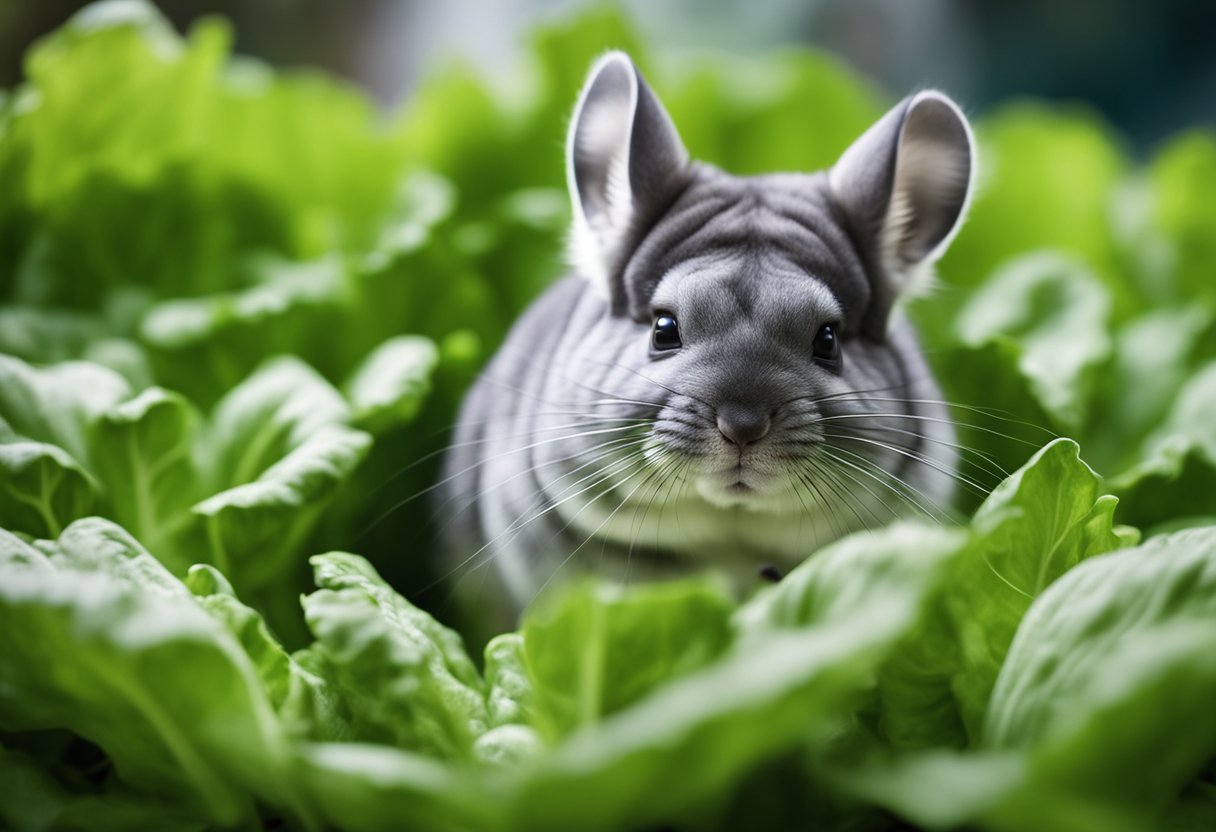Can Chinchillas Have Lettuce? Understanding the Dietary Needs of Your Pet Chinchilla
Chinchillas are popular pets known for their soft fur and curious nature. If you are a chinchilla owner, you might wonder if it’s safe to share your leafy greens with your furry friend. Chinchillas can eat lettuce, but it should be given sparingly due to its high water content and lack of essential nutrients.

While lettuce may seem like a healthy treat, it’s important to know that it should not be a staple in your chinchilla’s diet. Feeding too much can lead to digestive issues like bloating or diarrhea. There are better options that provide the necessary nutrients for your chinchilla’s health.
Understanding what to feed your chinchilla is essential for their well-being. By knowing the right foods, you can keep your pet happy and healthy for years to come.
Key Takeaways
- Lettuce can be fed to chinchillas in tiny amounts.
- A varied diet is crucial for your chinchilla’s health.
- Feeding habits should prioritize fiber and essential nutrients.
Nutritional Considerations for Chinchillas

When caring for chinchillas, understanding their dietary needs is essential. Your pet thrives on a diet rich in fiber and low in moisture. Lettuce, while safe in small amounts, is not ideal for meeting these requirements and can affect your chinchilla’s health.
Proper Chinchilla Diet
Chinchillas require a diet mainly composed of high-quality hay, which is rich in fiber. Hay helps maintain healthy digestion and prevents issues like bloating and diarrhea. You should also provide pellets specifically made for chinchillas, which contain balanced nutrients.
Foods to include:
- Timothy Hay: Excellent source of fiber.
- Pellets: Made for chinchillas, providing essential vitamins.
- Fresh Vegetables: Only in small servings; options like bell peppers are better choices than lettuce.
Avoid foods high in sugar or fat, such as fruits and treats, which can lead to obesity and other health problems.
Health Implications of Lettuce
Although chinchillas can eat lettuce in small amounts, it should not be a regular part of their diet. Lettuce has high water content and low fiber, which can lead to digestive upset. Types like iceberg lettuce contain minimal nutrition and may even cause gastrointestinal issues.
Potential issues from lettuce:
- Diarrhea: Excess moisture can disrupt digestion.
- Bloating: Sudden changes in diet can affect their sensitive systems.
- Low Nutritional Value: Lettuce lacks the necessary fiber to support your chinchilla’s health.
In summary, while it’s safe for a chinchilla to nibble on lettuce occasionally, you should prioritize their main dietary needs with high-fiber options for optimal health.
Feeding Lettuce to Chinchillas

Feeding lettuce to chinchillas requires careful consideration. While you can offer it, not all types are safe, and you should think about serving sizes. Knowing the right approach will help ensure your chinchilla stays healthy.
Types of Lettuce and Effects
Not all lettuce is created equal. Here are some common types and their effects on chinchillas:
- Iceberg Lettuce: This type has high water content but low nutritional value. It can lead to digestive upset.
- Romaine Lettuce: Romaine is better than iceberg but still should be given in small amounts. It has more nutrients and less water.
- Butterhead Lettuce: This variety is similar to romaine and can be offered occasionally but in limited quantities.
Stop feeding if you notice any digestive issues. Stick to small servings to avoid health risks.
Serving Size and Frequency
When it comes to serving size, moderation is key. A good rule of thumb is to offer a small piece of lettuce, about the size of your thumb, once or twice a week. Overfeeding can lead to:
- Diarrhea: Excess lettuce can upset your chinchilla’s stomach.
- Bloating: Too much watery food can cause discomfort.
Monitor your pet’s reaction. If your chinchilla shows signs of digestive problems, reduce the frequency or remove lettuce from their diet altogether. Always prioritize hay and pellets as their main food sources.
Resources
For more information on feeding chinchillas, consider these sources. These articles provide guidance on safe vegetable options and overall dietary needs:
- Can Chinchillas Eat Lettuce? (What You Need To Know)
- Can Chinchillas Eat Lettuce? – Berry Patch Farms
These resources help you make informed choices about your chinchilla’s diet.
Frequently Asked Questions

Chinchillas have specific dietary needs that can be tricky to navigate. Here are some common questions to help you understand what is safe and healthy for your pet.
What types of vegetables are safe for chinchillas to consume?
Chinchillas can eat a few types of vegetables, but some are better than others. Safe options include small amounts of leafy greens like spinach and kale. Always introduce any new vegetable gradually to avoid digestive issues.
How often can chinchillas be fed vegetables?
Vegetables should be an occasional treat for chinchillas. You can offer them small portions a few times a week. Too many vegetables can upset their stomachs due to high water content.
Are there any vegetables that are toxic to chinchillas?
Yes, some vegetables can be harmful. Avoid giving your chinchilla onions, garlic, and any members of the nightshade family, such as tomatoes and potatoes. These can cause serious health problems.
Can chinchillas have carrots as part of their diet?
Carrots can be fed to chinchillas, but only in small amounts. They are high in sugar, making them more of a treat than a regular food. A small piece occasionally should be fine.
What are the risks of feeding iceberg lettuce to chinchillas?
Iceberg lettuce has a high water content and can lead to bloating and diarrhea in chinchillas. It is best to avoid it altogether. Opt for safer greens when treating your pet.
What should be included in a chinchilla’s daily diet?
A chinchilla’s daily diet should mainly consist of unlimited hay, like timothy hay, and a small number of pellets. Occasional treats can include safe vegetables and limited fruits. Always prioritize their main dietary needs to keep them healthy.

